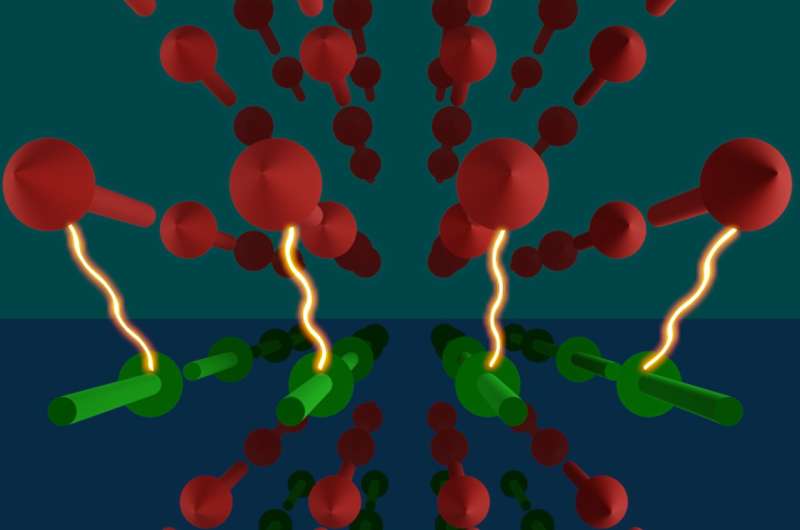This article has been reviewed according to Science X's editorial process and policies. Editors have highlighted the following attributes while ensuring the content's credibility:
fact-checked
peer-reviewed publication
proofread
Magnetic heterostructure generates higher frequencies for information processing

Novel magnetic memories are energy-efficient and robust. They are based on ferromagnets with operating frequencies in the gigahertz range. The operating frequency could be further increased with antiferromagnets, which, however, cannot be efficiently excited.
Researchers from Kaiserslautern and Mainz have now shown that magnetic heterostructures—based on a thin antiferromagnet/ferromagnet bilayer—can combine the advantages of both material classes: A high working frequency with efficient excitation. The work has been published in the journal Physical Review Letters and has been highlighted as an Editors' suggestion.
Magnetic materials play a central role in information processing and transmission in electronic devices. "We distinguish between different classes of magnets," says Professor Dr. Mathias Weiler, who heads the Applied Spin Phenomena group of the Department of Physics at the University Kaiserslautern-Landau.
"The ferromagnets have a net magnetization and are used as permanent magnets, which produce a stray field. They are easy to excite. Their dynamics are in the gigahertz range."
A second class of magnetic materials behaves quite differently: antiferromagnets. "From the outside, you can't tell that they have magnetization. They don't show any net magnetic moment that you can interact with. This makes them difficult to excite," explains Ph.D. student Hassan Al-Hamdo, first author of the current study.
Once they are excited, however, they exhibit much faster dynamics in the terahertz range. This fact makes them interesting for various fields of application, such as communication technologies and magnetic memories, as the processing speed could be accelerated significantly. "However, since antiferromagnets cannot be excited efficiently, their applications are limited," Weiler continues.
Together with research colleagues from Mainz, the researchers in Kaiserslautern have now shown how the faster dynamics of antiferromagnets can nevertheless be used. For their experiments, they relied on a hybrid material. "It consists of two thin layers, one ferromagnetic and one antiferromagnetic," explains Weiler. The ferromagnetic layer is a common nickel-iron compound that is also found in transformers, for example. The antiferromagnetic layer is a manganese-gold compound.
The special feature of the heterostructure is found in the arrangement of the spins directly at the antiferromagnetic-ferromagnetic interface. Al-Hamdo states, "The spin describes the intrinsic angular momentum of a quantum particle and is the basis of all magnetic phenomena. At the interface, we find a well-defined order of the spins.
"This leads to an unusually strong coupling of the antiferromagnetic and ferromagnetic spins. The coupling is so pronounced that the spins of the antiferromagnet align themselves based on the magnetization in the ferromagnet. This property is unique."
The heterostructure was developed by colleagues at Johannes Gutenberg University Mainz. Colleagues in Mainz also developed the theoretical model to explain the experimental results from Kaiserslautern.
"By using the unique properties of our heterostructure, we succeeded in transferring a magnetic excitation from the ferromagnet to the antiferromagnet. In doing so, we have obtained a higher frequency than is the case with the pure ferromagnet. The frequency is between that of the antiferromagnet and the ferromagnet," Weiler says.
These results are interesting for future applications. "For emerging mobile applications, higher frequencies will be needed," Weiler cites as an example. "With this coupling, we are getting into these areas." Fields of application could also be memory technologies such as Magnetic Random-Access Memory or microwave generation through spin-torque oscillators, where higher frequencies would increase performance.
More information: Hassan Al-Hamdo et al, Coupling of Ferromagnetic and Antiferromagnetic Spin Dynamics in Mn2Au/NiFe Thin Film Bilayers, Physical Review Letters (2023). DOI: 10.1103/PhysRevLett.131.046701
Journal information: Physical Review Letters
Provided by Rheinland-Pfälzische Technische Universität Kaiserslautern-Landau





















